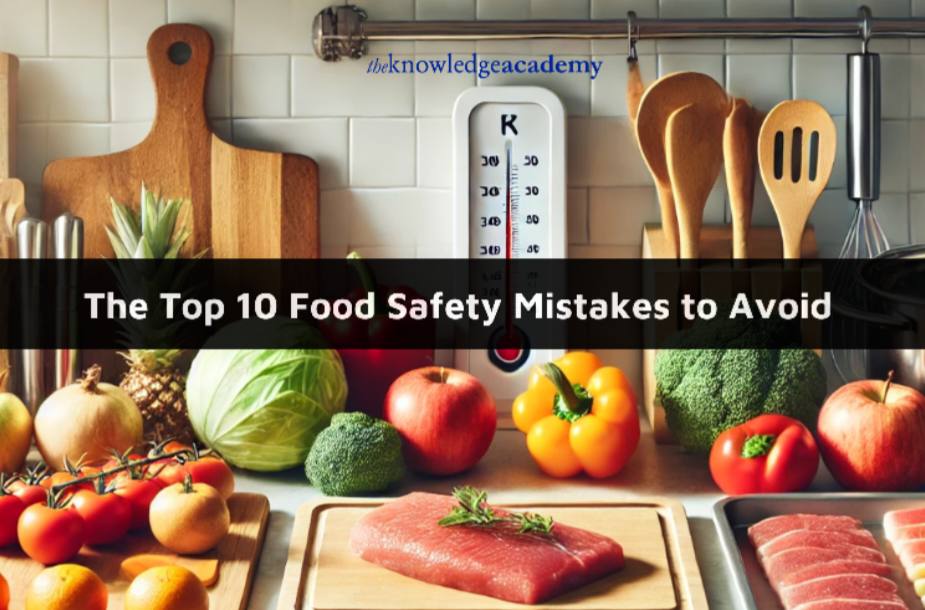Preventing foodborne illnesses and ensuring food safety rely on upholding high standards of food hygiene and safety practices. Even after completing Food Hygiene and Safety Training, many people often forget the Basic Principles of Food Safety during daily cooking routines. Whether running a professional kitchen or cooking at home, avoiding these common mistakes will ensure a safer and healthier food environment.
1. Not Doing Correct Hand Hygiene
One of the easiest but most underused actions in food safety is washing hands properly. Many believe a quick rinse under water is sufficient, but thorough handwashing requires scrubbing with soap for at least 20 seconds. This step is crucial before cooking and after handling raw foods like meat, poultry, or seafood. Improper handwashing can quickly spread dangerous pathogens such as Salmonella and E. coli, leading to serious illnesses.
How to avoid this mistake
Wash hands with soap for 20 seconds, especially after handling raw meat or visiting the toilet.
Dry hands using a clean towel or air dryer, as damp hands can spread germs.
2. Cross Contamination Between Raw and Cooked Food
Cross contamination occurs when bacteria from raw food transfer to cooked or ready to eat items. This typically happens when using the same tools or cutting boards without proper cleaning in between.
How to avoid this mistake
Use separate cutting boards for raw meat and other items.
Clean and disinfect surfaces, knives, and utensils after handling raw food.
3. Ignoring Expiry Dates
While it is easy to forget expiry dates, consuming food past its expiration can severely compromise your health. Expiry dates indicate when food is no longer safe to eat.
How to avoid this mistake
Always check the expiry date before using any product.
Rotate stock in your fridge and pantry to ensure older items are used first.
4. Incorrect Food Storage Temperatures
Improper storage temperatures are a common error that allows bacteria to proliferate. The "danger zone" for bacterial growth is between 5°C and 63°C. Therefore, perishable food should be refrigerated promptly and kept below 5°C.
How to avoid this mistake
Make sure your fridge is set to below 5°C.
Refrigerate leftovers within two hours of cooking.
5. Thawing Food at Room Temperature
Many people leave frozen food on the counter to thaw, but this can quickly allow bacteria to multiply. The outer layer of the food warms up while the centre remains frozen, creating the perfect environment for bacteria to thrive.
How to avoid this mistake
Thaw food in the fridge overnight, under cold water, or in the microwave.
Avoid leaving perishable foods out for more than two hours.
6. Underestimating the Importance of Personal Hygiene
It is easy to focus solely on food, but the personal hygiene of the food handler is just as important. Contaminants can be introduced when handling food while ill, wearing soiled clothing, or neglecting to tie back long hair.
How to avoid this mistake
Always wear clean clothing and tie back hair when cooking.
Avoid handling food if you are feeling unwell.
7. Cooking Food at Inappropriate Temperatures
Cooking food to the right temperature kills harmful bacteria. Many people, especially when rushing, undercook meals, resulting in foodborne illnesses.
How to avoid this mistake
Use a food thermometer to check that food has reached the correct internal temperature.
Always check the thickest part of the meat.
8. Using the Same Utensils Without Cleaning
Using the same utensils for raw and cooked food is a quick way to cross contaminate. This is a common mistake, especially when multitasking in the kitchen.
How to avoid this mistake
Use different utensils for raw and cooked foods.
Always clean cutting boards, utensils, and surfaces immediately after use.
9. Not Washing Fruits and Vegetables Properly
Though fruits and vegetables look clean, they can carry harmful bacteria or pesticides. Many people skip thoroughly washing produce, increasing the risk of foodborne illness.
How to avoid this mistake
Wash fruits and vegetables under running water before eating.
Use a clean brush to scrub firm produce like cucumbers or melons.
10. Neglecting to Clean Kitchen Surfaces Regularly
Kitchen surfaces, particularly worktops and cutting boards, can harbour bacteria from raw food. Ignoring their cleaning can contaminate the next food item prepared on them.
How to avoid this mistake
Clean and disinfect all surfaces after preparing food, especially after handling raw meat.
Use kitchen disinfectant or hot water and soap solution.
Conclusion
Food safety is not just about preventing foodborne illnesses. It is about safeguarding your health and the health of others. By being mindful of these common food safety mistakes and actively avoiding them, you can ensure that the food you prepare is safe and nutritious. Remember these top 10 mistakes, and you will be well on your way to mastering safe cooking techniques!
The Knowledge Academy offers food hygiene and safety courses to help you deepen your understanding of food safety principles.


